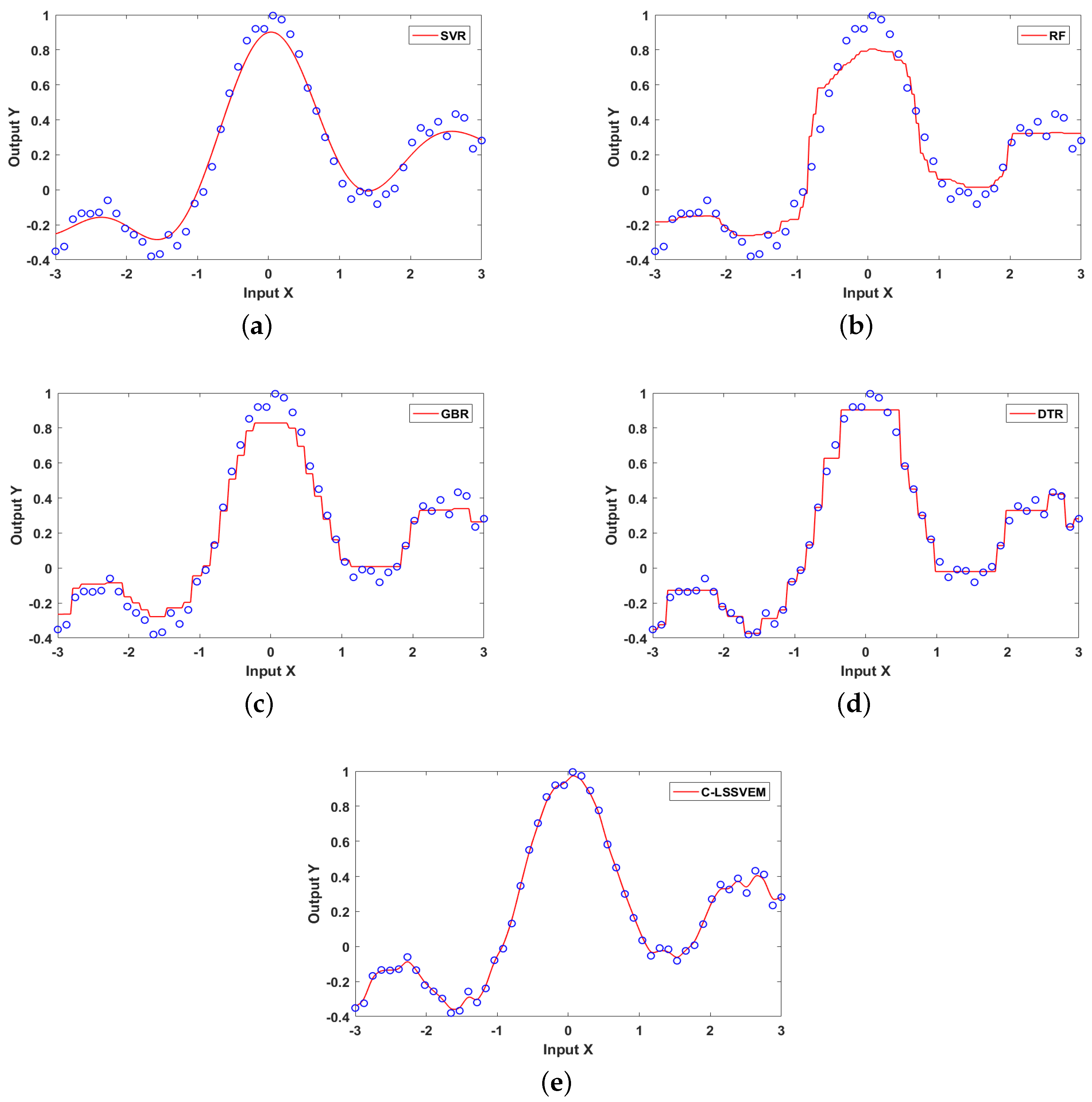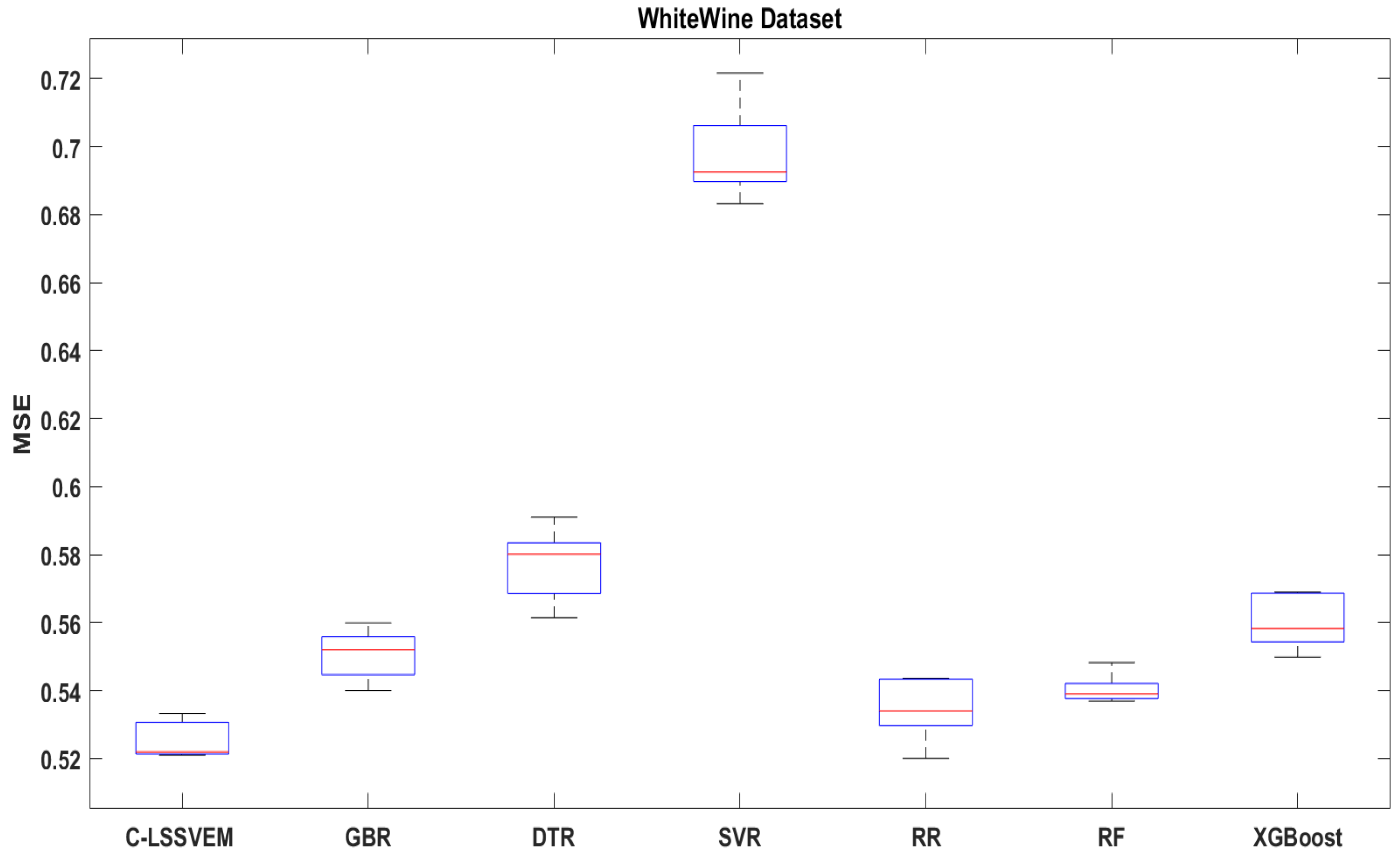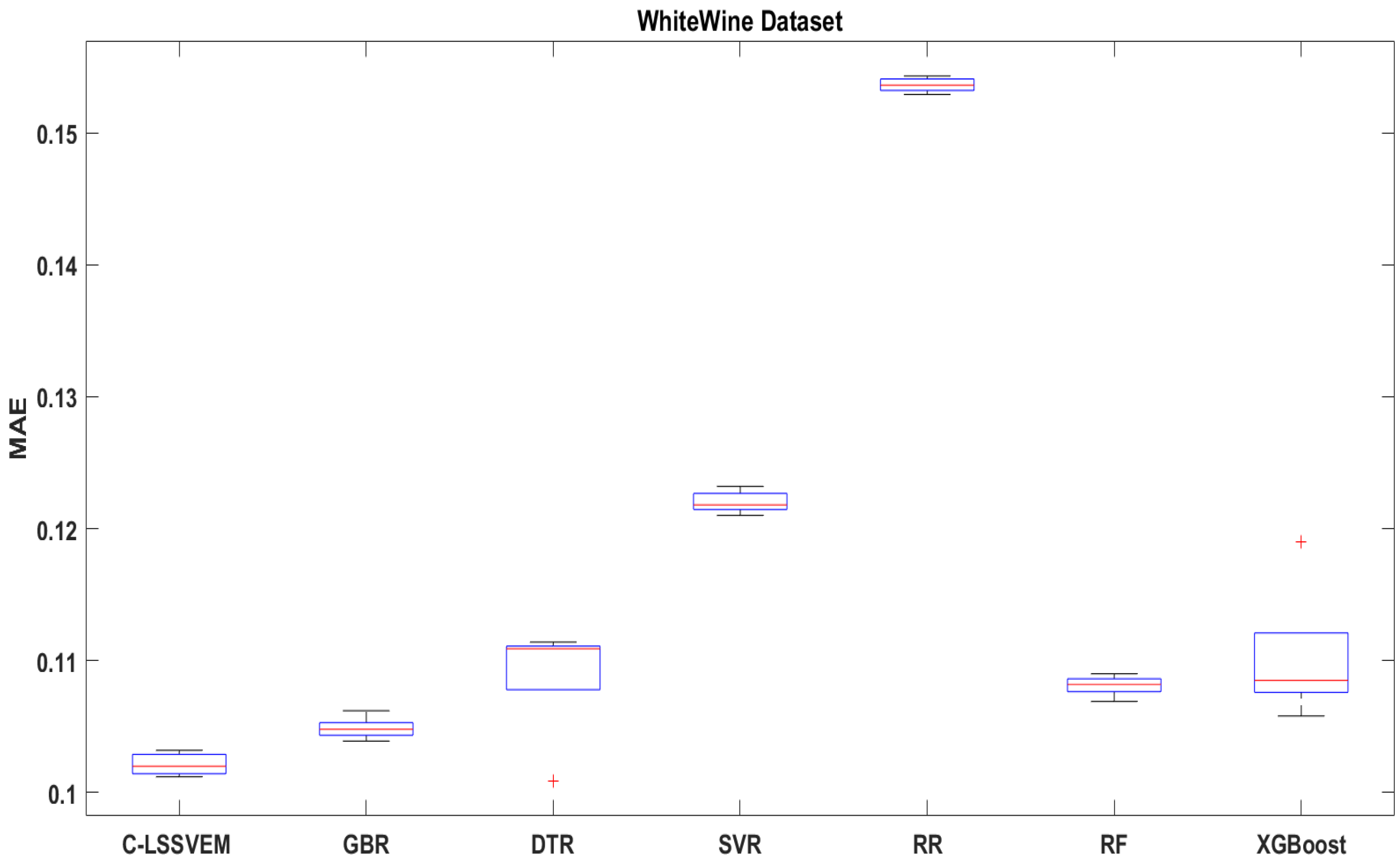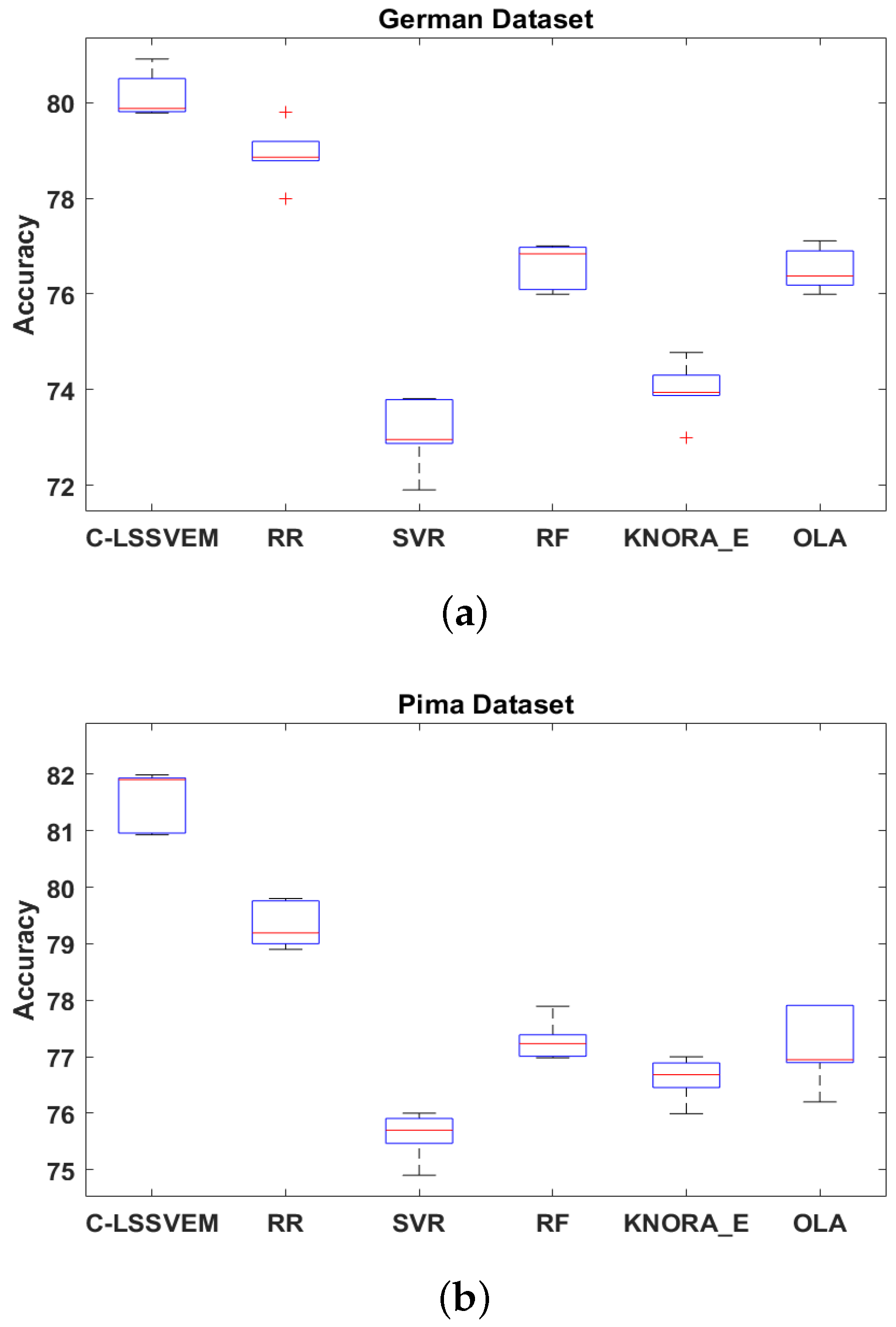Author Contributions
X.-J.S. and D.K.W. fabricated the algorithm; D.K.W. performed the experiments; X.-J.S. analyzed the results and provide supervision; D.K.W. drafted the manuscript; and X.-J.S. reviewed the paper.
Funding
This work was funded in part by the National Natural Science Foundation of China (No. 61572240).
Acknowledgments
The authors thank Elias Ocquaye, Abeo Timothy Apasiba, Ernest Ganaa, and Huang Chang Bin for their kind assistance, and also thanks to Rita Keddy for their motivation.
Conflicts of Interest
The authors declare no conflict of interest.
References
- Song, S.; Zhan, Z.; Long, Z.; Zhang, J.; Yao, L. Comparative study of SVM methods combined with voxel selection for object category classification on fMRI data. PLoS ONE 2011, 6, e17191. [Google Scholar] [CrossRef]
- Oliveira, P.P.d.M., Jr.; Nitrini, R.; Busatto, G.; Buchpiguel, C.; Sato, J.R.; Amaro, E., Jr. Use of SVM methods with surface-based cortical and volumetric subcortical measurements to detect Alzheimer’s disease. J. Alzheimer’s Dis. 2010, 19, 1263–1272. [Google Scholar] [CrossRef] [PubMed]
- Suykens, J.A.; Van Gestel, T.; De Brabanter, J. Least Squares Support Vector Machines; World Scientific: London, UK, 2002. [Google Scholar]
- Long, B.; Xian, W.; Li, M.; Wang, H. Improved diagnostics for the incipient faults in analog circuits using LSSVM based on PSO algorithm with Mahalanobis distance. Neurocomputing 2014, 133, 237–248. [Google Scholar] [CrossRef]
- Yang, L.; Yang, S.; Li, S.; Zhang, R.; Liu, F.; Jiao, L. Coupled compressed sensing inspired sparse spatial-spectral LSSVM for hyperspectral image classification. Knowl. Based Syst. 2015, 79, 80–89. [Google Scholar] [CrossRef]
- Mehrkanoon, S.; Suykens, J.A. Learning solutions to partial differential equations using LS-SVM. Neurocomputing 2015, 159, 105–116. [Google Scholar] [CrossRef]
- Gao, Y.; Shan, X.; Hu, Z.; Wang, D.; Li, Y.; Tian, X. Extended compressed tracking via random projection based on MSERs and online LS-SVM learning. Pattern Recognit. 2016, 59, 245–254. [Google Scholar] [CrossRef]
- Lu, X.; Zou, W.; Huang, M. Robust spatiotemporal LS-SVM modeling for nonlinear distributed parameter system with disturbance. IEEE Trans. Ind. Electron. 2017, 64, 8003–8012. [Google Scholar] [CrossRef]
- Liu, J.; Wang, Y.; Fu, C.; Guo, J.; Yu, Q. A robust regression based on weighted LSSVM and penalized trimmed squares. Chaos Solitons Fractals 2016, 89, 328–334. [Google Scholar] [CrossRef]
- An, S.; Liu, W.; Venkatesh, S. Fast cross-validation algorithms for least squares support vector machine and kernel ridge regression. Pattern Recognit. 2007, 40, 2154–2162. [Google Scholar] [CrossRef]
- Wu, H.; Cai, Y.; Wu, Y.; Zhong, R.; Li, Q.; Zheng, J.; Lin, D.; Li, Y. Time series analysis of weekly influenza-like illness rate using a one-year period of factors in random forest regression. Biosci. Trends 2017, 11, 292–296. [Google Scholar] [CrossRef] [Green Version]
- Svetnik, V.; Liaw, A.; Tong, C.; Culberson, J.C.; Sheridan, R.P.; Feuston, B.P. Random forest: A classification and regression tool for compound classification and QSAR modeling. J. Chem. Inf. Comput. Sci. 2003, 43, 1947–1958. [Google Scholar] [CrossRef]
- Wang, Y.; Feng, D.; Li, D.; Chen, X.; Zhao, Y.; Niu, X. A mobile recommendation system based on logistic regression and Gradient Boosting Decision Trees. In Proceedings of the International Joint Conference on Neural Networks (IJCNN), Vancouver, BC, Canada, 24–29 July 2016; pp. 1896–1902. [Google Scholar]
- Zhang, F.; Du, B.; Zhang, L. Scene classification via a gradient boosting random convolutional network framework. IEEE Trans. Geosci. Remote Sens. 2016, 54, 1793–1802. [Google Scholar] [CrossRef]
- Rathore, S.S.; Kumar, S. A decision tree regression based approach for the number of software faults prediction. ACM SIGSOFT Softw. Eng. Notes 2016, 41, 1–6. [Google Scholar] [CrossRef]
- Schmidt, U.; Jancsary, J.; Nowozin, S.; Roth, S.; Rother, C. Cascades of regression tree fields for image restoration. IEEE Trans. Pattern Anal. Mach. Intell. 2016, 38, 677–689. [Google Scholar] [CrossRef] [PubMed]
- Lei, Z.; Li, S.Z. Coupled spectral regression for matching heterogeneous faces. In Proceedings of the IEEE Conference on Computer Vision and Pattern Recognition, Miami, FL, USA, 20–25 June 2009; pp. 1123–1128. [Google Scholar]
- Zhang, W.; Wang, X.; Tang, X. Coupled information-theoretic encoding for face photo-sketch recognition. In Proceedings of the 2011 IEEE Conference on Computer Vision and Pattern Recognition (CVPR), Colorado Springs, CO, USA, 20–25 June 2011; pp. 513–520. [Google Scholar]
- Kalteh, A.M. Monthly river flow forecasting using artificial neural network and support vector regression models coupled with wavelet transform. Comput. Geosci. 2013, 54, 1–8. [Google Scholar] [CrossRef]
- Adamowski, J.; Chan, H.F.; Prasher, S.O.; Sharda, V.N. Comparison of multivariate adaptive regression splines with coupled wavelet transform artificial neural networks for runoff forecasting in Himalayan micro-watersheds with limited data. J. Hydroinformat. 2012, 14, 731–744. [Google Scholar] [CrossRef]
- Edmunds, C.W.; Hamilton, C.; Kim, K.; Andre, N.; Labbe, N. Rapid Detection of Ash and Inorganics in Bioenergy Feedstocks Using Fourier Transform Infrared Spectroscopy Coupled with Partial Least-Squares Regression. Energy Fuels 2017, 31, 6080–6088. [Google Scholar] [CrossRef]
- Yang, T.; Zhou, R.; Jiang, D.; Fu, H.; Su, R.; Liu, Y.; Su, H. Rapid Detection of Pesticide Residues in Chinese Herbal Medicines by Fourier Transform Infrared Spectroscopy Coupled with Partial Least Squares Regression. J. Spectrosc. 2016, 2016, 1–9. [Google Scholar] [CrossRef]
- Shen, X.J.; Dong, Y.; Gou, J.P.; Zhan, Y.Z.; Fan, J. Least squares kernel ensemble regression in Reproducing Kernel Hilbert Space. Neurocomputing 2018, 311, 235–244. [Google Scholar] [CrossRef]
- Suykens, J.A.; Vandewalle, J. Least squares support vector machine classifiers. Neural Process. Lett. 1999, 9, 293–300. [Google Scholar] [CrossRef]
- Zheng, H.; Zhang, Y.; Liu, J.; Wei, H.; Zhao, J.; Liao, R. A novel model based on wavelet LS-SVM integrated improved PSO algorithm for forecasting of dissolved gas contents in power transformers. Electr. Power Syst. Res. 2018, 155, 196–205. [Google Scholar] [CrossRef]
- Wen, X.; Tu, C.; Wu, M.; Jiang, X. Fast ranking nodes importance in complex networks based on LS-SVM method. Phys. A Stat. Mech. Appl. 2018, 506, 11–23. [Google Scholar] [CrossRef]
- Polikar, R. Ensemble based systems in decision making. IEEE Circuits Syst. Mag. 2006, 6, 21–45. [Google Scholar] [CrossRef]
- Freund, Y.; Schapire, R.E. A decision-theoretic generalization of on-line learning and an application to boosting. J. Comput. Syst. Sci. 1997, 55, 119–139. [Google Scholar] [CrossRef]
- Breiman, L. Random forests. Mach. Learn. 2001, 45, 5–32. [Google Scholar] [CrossRef]
- Friedman, J.H. Greedy function approximation: A gradient boosting machine. Ann. Stat. 2001, 29, 1189–1232. [Google Scholar] [CrossRef]
- Freund, Y.; Schapire, R.E. Experiments with a new boosting algorithm. Icml 1996, 96, 148–156. [Google Scholar]
- Moghimi, M.M.; Nayeri, M.; Pourahmadi, M.; Moghimi, M.K. Moving Vehicle Detection Using AdaBoost and Haar-Like Feature in Surveillance Videos. arXiv 2018, arXiv:1801.01698. [Google Scholar]
- Yin, F.; Wu, R.; Yu, X.; Sun, G. Video text localization based on Adaboost. Multimed. Tools Appl. 2018, 78, 5345–5354. [Google Scholar] [CrossRef]
- Melville, B.; Lucieer, A.; Aryal, J. Object-based random forest classification of Landsat ETM+ and WorldView-2 satellite imagery for mapping lowland native grassland communities in Tasmania, Australia. Int. J. Appl. Earth Obs. Geoinf. 2018, 66, 46–55. [Google Scholar] [CrossRef]
- Jog, A.; Carass, A.; Roy, S.; Pham, D.L.; Prince, J.L. Random forest regression for magnetic resonance image synthesis. Med. Image Anal. 2017, 35, 475–488. [Google Scholar] [CrossRef] [PubMed]
- Li, T.R.; Chamrajnagar, A.S.; Fong, X.R.; Rizik, N.R.; Fu, F. Sentiment-based prediction of alternative cryptocurrency price fluctuations using gradient boosting tree model. arXiv 2018, arXiv:1805.00558. [Google Scholar]
- Touzani, S.; Granderson, J.; Fernandes, S. Gradient boosting machine for modeling the energy consumption of commercial buildings. Energy Build. 2018, 158, 1533–1543. [Google Scholar] [CrossRef] [Green Version]
- Mercer, B. XVI. Functions of positive and negative type, and their connection the theory of integral equations. Phil. Trans. R. Soc. Lond. A 1909, 209, 415–446. [Google Scholar] [CrossRef]
- Chen, T.; Guestrin, C. Xgboost: A scalable tree boosting system. In Proceedings of the 22nd ACM Sigkdd International Conference on Knowledge Discovery And Data Mining, San Francisco, CA, USA, 13–17 August 2016; pp. 785–794. [Google Scholar]
- Wornyo, D.K.; Shen, X.J.; Dong, Y.; Wang, L.; Huang, S.C. Co-regularized kernel ensemble regression. World Wide Web 2018, 22, 717–734. [Google Scholar] [CrossRef]
- Oliveira, D.V.; Cavalcanti, G.D.; Porpino, T.N.; Cruz, R.M.; Sabourin, R. K-Nearest Oracles Borderline Dynamic Classifier Ensemble Selection. arXiv 2018, arXiv:1804.06943. [Google Scholar]
- Cruz, R.M.; Sabourin, R.; Cavalcanti, G.D. Prototype selection for dynamic classifier and ensemble selection. Neural Comput. Appl. 2018, 29, 447–457. [Google Scholar] [CrossRef]
- Hong, H.; Liu, J.; Bui, D.T.; Pradhan, B.; Acharya, T.D.; Pham, B.T.; Zhu, A.X.; Chen, W.; Ahmad, B.B. Landslide susceptibility mapping using J48 Decision Tree with AdaBoost, Bagging and Rotation Forest ensembles in the Guangchang area (China). Catena 2018, 163, 399–413. [Google Scholar] [CrossRef]
- Morvant, E.; Habrard, A.; Ayache, S. Majority Vote of Diverse Classifiers for late Fusion; Joint IAPR International Workshops on Statistical Techniques in Pattern Recognition (SPR) and Structural and Syntactic Pattern Recognition (SSPR); Springer: Berlin, Germany, 2014; pp. 153–162. [Google Scholar]
- Cai, C.; Wornyo, D.K.; Wang, L.; Shen, X. Building Weighted Classifier Ensembles Through Classifiers Pruning. In Proceedings of the International Conference on Internet Multimedia Computing and Service, Qingdao, China, 23–25 August 2017; pp. 131–139. [Google Scholar]
- Alom, M.Z.; Taha, T.M.; Yakopcic, C.; Westberg, S.; Hasan, M.; Van Esesn, B.C.; Awwal, A.A.S.; Asari, V.K. The History Began from AlexNet: A Comprehensive Survey on Deep Learning Approaches. arXiv 2018, arXiv:1803.01164. [Google Scholar]
- Muhammad, U.; Wang, W.; Chattha, S.P.; Ali, S. Pre-trained VGGNet Architecture for Remote-Sensing Image Scene Classification. In Proceedings of the 2018 24th International Conference on Pattern Recognition (ICPR), Beijing, China, 20 August 2018; pp. 1622–1627. [Google Scholar]
- Cheng, G.; Han, J.; Lu, X. Remote sensing image scene classification: Benchmark and state of the art. Proc. IEEE 2017, 105, 1865–1883. [Google Scholar] [CrossRef]
© 2019 by the authors. Licensee MDPI, Basel, Switzerland. This article is an open access article distributed under the terms and conditions of the Creative Commons Attribution (CC BY) license (http://creativecommons.org/licenses/by/4.0/).










